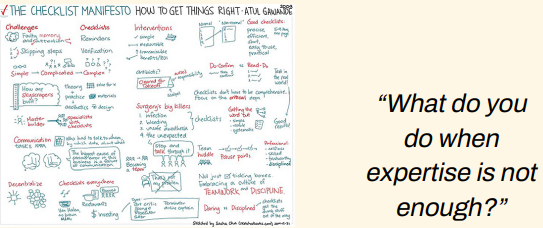6.2: Trailblazer
- Page ID
- 134158
Proposal Trailblazer: Atul Gawande

Figure \(6.2\) Atul Gawande (https://openstax.org/r/atulgawande) thinks graphically about solving problems. (credit: “Sketched Book - The Checklist Manifesto - How to Get Things Right” by Sacha Chua/ flickr, CC BY 2.0)
By the end of this section, you will be able to:
- Describe a particular problem and a proposed solution.
- Discuss the process of identifying a problem and proposing a solution.
- Articulate how proposals to solve problems reach their intended audience.
Medical Problem Solver
Born in New York City, surgeon and author Atul Gawande (b. 1965) graduated from Stanford University in 1987 with a degree in biology and political science. A Rhodes Scholarship enabled him to study at the University of Oxford, where he earned a master’s degree in philosophy, politics, and economics. Returning to the United States from England, Gawande entered politics and worked for Al Gore’s (b. 1948) presidential campaign and later served as a health care adviser during the Clinton administration (1993–2001). Gawande graduated from Harvard Medical School with an MD in 1995 and an MPH (master of public health) in 1999. Among his main concerns and frequent topics of his written work have been patient care and medical ethics.
In the mid-2000s, Dr. Gawande came across a simple idea for improving medical care. Another physician, Peter Pronovost (b. 1965), a critical care specialist, had identified a solution to the problem of patients in intensive care units (ICUs) developing infections after having central intravenous lines inserted. The cause of the problem was human error. Doctors knew the steps they needed to follow to prevent infection when they inserted a central line, but some of them skipped at least one of the steps. When they did, the risk of a dangerous infection increased, which in turn increased the likelihood of a poor outcome for the patient—longer illness, additional surgery, or death.
Borrowing a method from airplane pilots, who must go through a checklist before being cleared for takeoff, Dr. Pronovost proposed a similar solution for ICU doctors: a checklist of five things they needed to do when inserting a central intravenous line. Dr. Pronovost ran an experiment in the ICU at the hospital where he worked. Doctors were instructed to follow the steps on the checklist, and nurses who assisted during the procedure were told to observe and speak up if a doctor skipped a step.
The checklist worked. The infection rate dropped dramatically, reducing ICU stays, saving lives, and saving money. Dr. Pronovost began writing checklists for other ICU situations. These checklists were successful as well in addressing particular problems.
Approached by the World Health Organization, Dr. Gawande worked with a team around the world to develop a checklist to improve the safety of surgery. As a surgeon, he was well aware of complications that could occur as a result of mistakes before, during, and after surgery. The team created a 19-point “safe surgery” checklist that was tested at eight hospitals around the world, including one in the United States. The checklist worked again—all eight hospitals saw the rate of significant postsurgical complications and deaths drop by an average of more than 35 percent, with no additional costs.
The problem the two doctors identified is both simple and complex. The problem is not that doctors lack knowledge; the problem is that because the situations they encounter are often complicated and urgent, doctors do not always correctly apply what they know.
The solution proposed by Dr. Gawande and Dr. Pronovost is similarly both simple and complex: to improve accuracy, use a checklist. However, other doctors needed to be convinced that a simple change like this would improve medical care. To persuade others, Gawande and Pronovost wrote articles for medical journals in which they presented the problem they studied, the methods they used, the results of their experiments, and the solution they recommended. Dr. Gawande then went on to apply the checklist solution to preventable problems in fields outside of medicine in his book The Checklist Manifesto: How to Get Things Right (2009), which became a best seller.
Discussion Questions
- How did Drs. Pronovost and Gawande define the problems they were trying to solve?
- What evidence did Drs. Pronovost and Gawande use to support their proposed solutions?
- Who was the audience for the doctors’ proposals? Why might some audience members be hesitant about accepting the checklist solution?
- Think about the relationship between doctors and nurses. Who has more authority in a medical setting? How might the doctors’ and nurses’ reactions to using the checklist differ?
- In what ways is the problem the doctors tackled both simple and complex?
- In what ways is the solution the doctors proposed both simple and complex?


